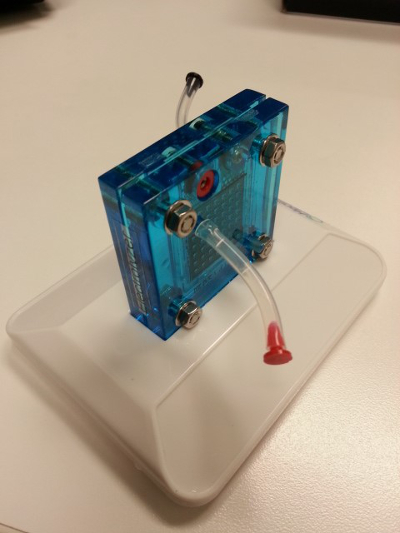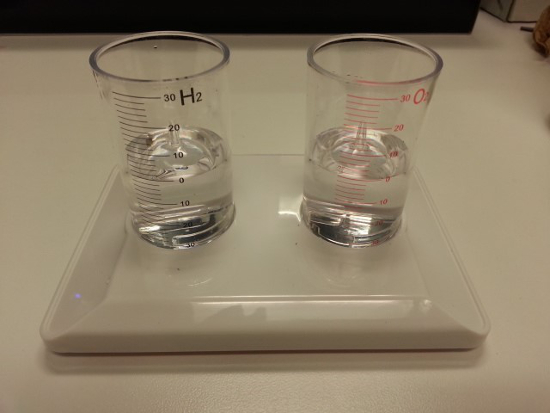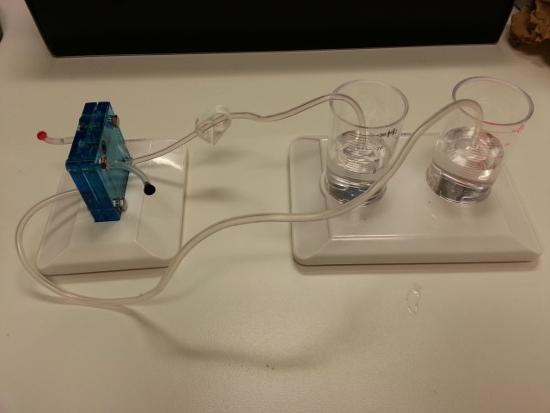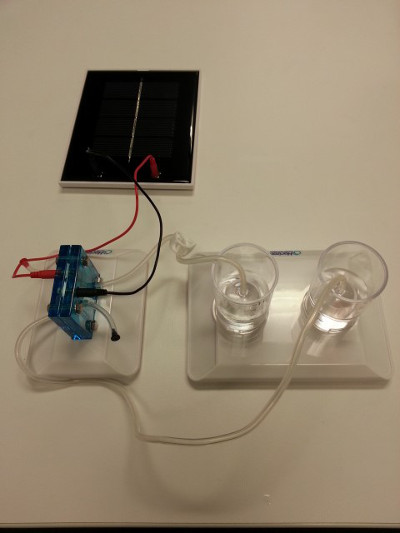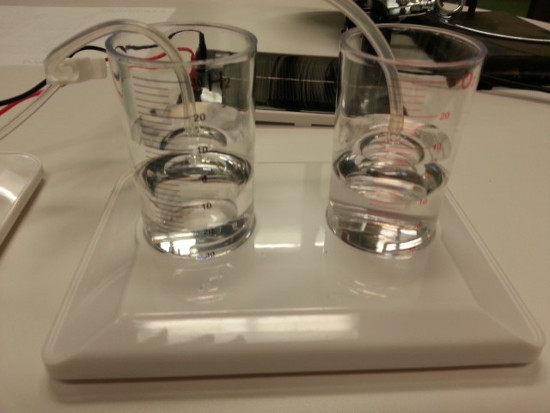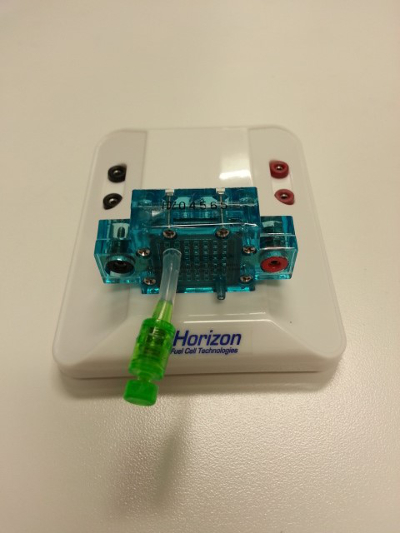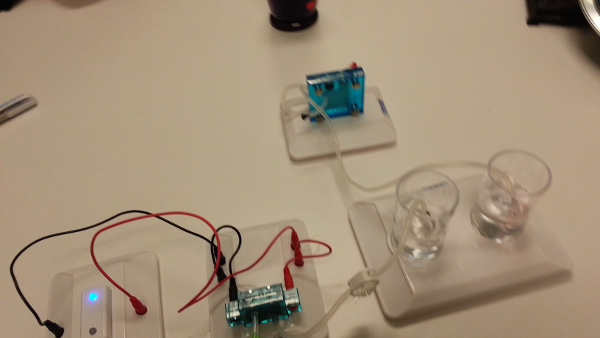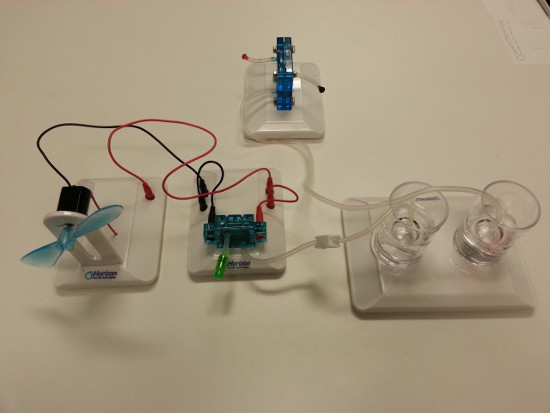양성자 교환막 연료 전지
Overview
출처: 마가렛 노동자와 킴벌리 프라이의 실험실 - 데폴 대학
미국은 많은 양의 에너지를 소비합니다 - 현재 속도는 매년 약 97.5 quadrillion BtUs입니다. 대다수 (90%) 이 에너지의 재생 불가능한 연료 공급원에서 비롯됩니다. 이 에너지는 전기(39%), 운송(28%), 산업(22%), 주거/상업용 이용(11%)에 사용됩니다. 세계가 이러한 재생 불가능한 자원의 공급이 제한되어 있기 때문에 미국은 미래의 에너지 수요를 충족시키기 위해 재생 가능 에너지원의 사용을 확대하고 있습니다. 이러한 소스 중 하나는 수소입니다.
수소는 잠재적인 재생 연료원으로 간주됩니다, 그것은 많은 중요한 기준을 충족하기 때문에: 그것은 국내에서 사용할 수, 그것은 몇 가지 유해한 오염 물질을 가지고, 그것은 에너지 효율, 그리고 그것은 활용하기 쉽습니다. 수소는 우주에서 가장 풍부한 원소이지만, 지구상의 복합 형태에서만 발견된다. 예를 들어, H2O로서 물에 산소와 결합된다. 연료로 유용하려면 H2 가스의 형태여야 합니다. 따라서 수소가 자동차 나 다른 전자 제품의 연료로 사용되려면 H2를 먼저 만들어야합니다. 따라서 수소는 종종 "연료"가 아닌 "에너지 캐리어"라고 합니다.
현재H2 가스를 만드는 가장 인기있는 방법은 탄화수소 또는 석탄 가스화의 증기 개혁을 통해 화석 연료에서 입니다. 이것은 화석 연료에 대한 의존도를 감소시키지 않으며 에너지 집약적입니다. 덜 사용되는 방법은 물의 전동 분해에 의한 것입니다. 이를 위해서는 에너지원이 필요하지만 풍력이나 태양광 발전과 같은 재생 가능한 원천이 될 수 있습니다. 전기 분해에서,물(H2O)은 전기화학반응을 통해 부품, 수소가스(H2) 및 산소가스(O2)로 분할된다. 전기 분해 과정을 통해 만들어진 수소 가스는 양성자 교환 멤브레인(PEM) 연료 전지에서 사용될 수 있어 전류를 생성합니다. 이 전류는 모터, 조명 및 기타 전기 장치에 전력을 공급하는 데 사용할 수 있습니다.
Procedure
1. 전해질기를 사용하여 수소 가스를 생산합니다.
- 전해질기 설정(그림 3).
- 가스 수집 실린더를 설정하여 외부 실린더의 증류수 수위가 0마크(도4)에있는지 확인합니다.
- 전해질기를 가스 수집 실린더에연결합니다(그림 5).
- 점퍼 와이어를 사용하여 전해질에 태양 전지판을 연결하고 직사광선에 노출시다(그림6). 날씨가 그날 협조하지 않는 경우 전구가 있는 램프를 사용하여 태양을 시뮬레이션합니다.
- H2 및 O2 가스가 내부 실린더(그림7)에진입하기 시작합니다. 외부 실린더에 표시된 스케일을 사용하여 30-s 간격으로 생성된 각 가스의 부피를 모니터링합니다. 내부 실린더를 H2 가스로 채우는 데 약 10분이 걸립니다.
- 내부 실
Results
Application and Summary
수소는 유연한 연료입니다. 현지 용도로 소량 또는 중앙 집중식 시설에서 대량으로 현장에서 생산할 수 있습니다. 수소는 부산물로만 물을 사용하여 전기를 생산하는 데 사용할 수 있습니다(풍력 터빈과 같은 재생 가능한 에너지원이 수소 가스를 생성하는 데 사용되었습니다). 예를 들어 콜로라도 볼더에서 Wind2H2 프로젝트에는 풍력 터빈과 태양전지 패널이 있어 물에서 수소 가스를 생산한 다음 ?...
Tags
건너뛰기...
이 컬렉션의 비디오:

Now Playing
양성자 교환막 연료 전지
Environmental Science
22.2K Views

나무 식별: 이분법적 열쇠를 사용하는 방법
Environmental Science
81.4K Views

나무 조사: 점 중심 쿼터 샘플링 방법
Environmental Science
49.5K Views

GIS를 사용한 도시 임업 조사
Environmental Science
12.7K Views

바이오 연료: 셀룰로오스 물질에서 에탄올 생산
Environmental Science
53.5K Views

유전자 변형 식품 검사
Environmental Science
90.1K Views

표층수의 탁도 및 총 고형분
Environmental Science
35.9K Views

표층수의 용존 산소
Environmental Science
56.0K Views

수생 생태계의 영양소
Environmental Science
39.0K Views

대류권 오존 측정
Environmental Science
26.5K Views

UV-VIS 분광기를 이용한 자동차 배기 가스의 NOx 측정
Environmental Science
30.3K Views

원자 흡수 분광법을 사용한 토양의 납 분석
Environmental Science
125.9K Views

환경 검체의 탄소 및 질소 분석
Environmental Science
29.6K Views

토양 영양소 분석: 질소, 인 및 칼륨
Environmental Science
216.2K Views

토양의 지렁이 개체군 분석
Environmental Science
16.6K Views
Copyright © 2025 MyJoVE Corporation. 판권 소유
